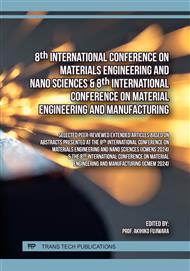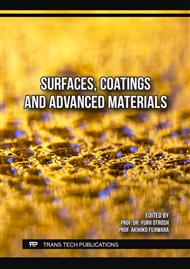p.3
p.11
p.17
p.25
p.31
p.39
p.47
p.57
Chemical Constituents and their Nanoemulsion Properties of Ethyl Acetate Crude Extract from Black Galingale Rhizome
Abstract:
Black galingale is a medicinal plant that has medicinal properties. The major constituents found in black galingale rhizomes are flavonoids, which display antioxidant activities. Therefore, in this research, the focus is to isolate and structurally determine bioactive compounds from the ethyl acetate extract of black galingale rhizomes and evaluate their antioxidant and antimicrobial activity, The black galingale rhizomes were extracted by maceration using ethyl acetate as a solvent. the compounds were isolated by column chromatography using hexane: ethyl acetate as an eluent solvent system. The isolated compounds were examined and characterized using FT-IR, UV-Vis, and NMR techniques, examined antioxidant activity by DPPH assay, and antimicrobial activity. From the extraction of ethyl acetate extract, it was found that 4 pure flavonoid compounds could be extracted. The FT-IR spectral data of 4 compounds showed a unique vibration corresponding to OH stretching, CH stretching, C=O stretching, C=C stretching of an aromatic ring, and C-O-C bond. Antioxidant activity testing by DPPH assay found 5-hydroxy-3,7-dimethoxyflavone (1) to have the highest antioxidant activity at 73.79% compared to the standard Trolox with 133.37±1.60 mM. Antimicrobial activity testing found that 3,5,7-trimethoxyflavone (3) showed the best growth inhibition activities against B. megaterium and S. aureus, Moreover, it studies the nanoemulsion properties of 5-hydroxy-3,7-dimethoxyflavone (1) was found stable with a nanoparticle size of 21.1 nm, a zeta potential of-49.7 mV, and has PDI of 0.227. Therefore, this research shows that the extract from black galingale rhizome could be used as an active ingredient in the cosmetics industry.
Info:
Periodical:
Pages:
25-30
Citation:
Online since:
September 2024
Keywords:
Price:
Сopyright:
© 2024 Trans Tech Publications Ltd. All Rights Reserved
Share:
Citation:



